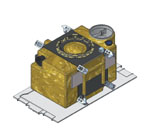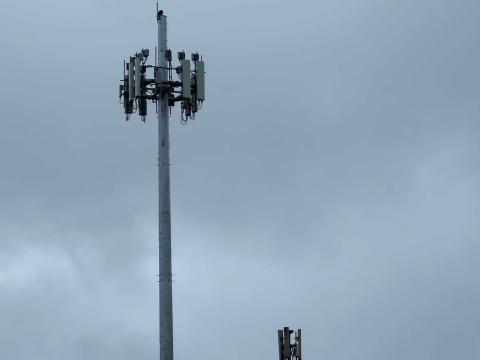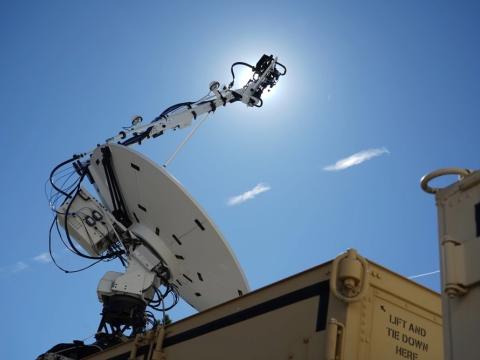Heavenly Hosts to Improve Satellites
 |
| The Air Force Research Laboratory (AFRL) Space Vehicles Directorate at Kirtland Air Force Base and Lockheed Martin and its subcontracting team are working on the Autonomous Nanosatellite Guardian Evaluating Local Space (ANGELS) program, which will create a nanosatellite solution for independent localized space situational awareness and anomaly characterization of a host satellite. |
Researchers are looking to improve satellites by studying their functions in space. By sending up nanosatellites for the satellites, scientists can determine problems more accurately and fix defects before launch, saving money and time and reducing the debris in space.
Personnel at the Air Force Research Laboratory (AFRL) Space Vehicles Directorate at Kirtland Air Force Base,
Capt. Luke Sauter, USAF, ANGELS program manager, states that not much research is conducted on space situational awareness. He hopes the program will help improve future space situational awareness—the understanding of what is in the space environment. Space situational awareness can include tracking an object in orbit, tracking and determining an orbit, and identifying the object. By improving space situational awareness, researchers can increase the level of detail of the images they receive from space, getting into exquisite characterization in which they can see the nuts and bolts of an object and do anomaly characterization.
ANGELS is the first nanosatellite experiment at geosynchronous orbit. “It’s a challenging problem,” Capt. Sauter says. “We’ve got basically full space situational awareness functionality in a very small, low-cost, easily launchable package.”
The program does not have specific relevance to the
The project is in Phase 3, which will continue through the critical design review scheduled through August 2007. The Air Force then plans to pursue a prototype unit with a flight demonstration in 2008 or 2009. The service is working with Lockheed Martin Corporation in
The nanosatellites will give personnel on the ground a better idea of what causes larger satellites to malfunction. “Often when satellites have a failure, they just die on orbit,” Capt. Sauter explains. “There’s no good way to find out what happened to that satellite.”
Without data on satellite failures, engineers are left to make predictions and assumptions about functioning, with little means to verify their theories. By using a nanosatellite to circle a larger satellite and send data back to ground control, scientists have access to more information and can find solutions to improve future satellites. Using the nanosatellites is a less expensive alternative to launching the larger satellites when problems have not been clearly identified or remedied. “It’s a pretty low-cost, easy solution,” Capt. Sauter says.
The analyses from the ANGELS program also could spur new ways of working with larger systems, and the new technologies demonstrated on the nanosatellites could have direct applicability to other programs. Kennedy believes that lessons that come out of the ANGELS missions could make larger programs more affordable and less complex.
ANGELS developers are hoping to reduce the failure rate of orbital systems. Instead of sending up a major satellite that potentially could have the same problems as failed systems, users could spend less by using ANGELS to examine problems before launching the new large system.
Scientists on the ground have the ability now to look at photographs of a space shuttle or a satellite such as Hubble, but the images do not provide enough detail. Nor can the ground crew change the angle from which the photographs have been taken. ANGELS could provide data that will help researchers understand what space situational awareness they can provide and could offer more imagery detail to improve understanding of what is happening in space. “We’re going to focus more on characterization … what we need to see on the satellite,” the captain explains.
 |
| An ANGELS satellite would circle a larger satellite to provide information to scientists and engineers on the ground. The information would be used to diagnose problems and to improve larger systems before new ones are launched. |
“We’re going to try to solve problems,” Capt. Sauter shares. “This is more to benefit the next-generation acquisitions.” He believes it will help build better systems in the future by providing input to make the bigger satellites lighter, equip them with better imaging systems or other equipment, and improve anomaly characterization activities.
Kennedy states that ANGELS is not a nanotechnology breakthrough, but is an innovation because the technology is packaged in a nanosatellite. The researchers are determining which available data sets, technologies, components and systems can be packed into a nanosatellite device to obtain the desired capability without taking on too much risk.
Though nanosatellites are common, ANGELS will provide a new capability—diagnostics. Currently, there is no space device that performs diagnostic examinations on satellites. Scientists have to analyze the problem based on the last set of telemetry they received. ANGELS can provide an additional set of data for engineers to use when analyzing problems.
Capt. Sauter says the program is on schedule to meet its projected launch date. “Right now, the way we’re set up, we’re really looking to assume mature technology we can put in space at a relatively low cost,” he explains.
Program personnel have not yet identified the host satellite for the first ANGELS flight or finalized a launch option. Capt. Sauter says the best option is to use an attachment ring under a primary satellite that would attach a secondary satellite.
The officer adds that the host satellite also probably will be experimental. Personnel at the AFRL will control the nanosatellite and provide image analysts with the material ANGELS supplies so they can determine what is of value and what is missing. For example, analysts might determine that having multicolor pictures would improve the data received.
ANGELS could be launched in several ways, including as a free flyer or as a secondary payload. The satellites will have specific missions with few requirements and a short time line—between one and three years depending on the orbit. After they finish their mission, they will go into the geograveyard, an orbit for spacecraft that no longer perform missions. This prevents the crafts from interfering with the orbits of functioning devices.
Researchers are able to experiment with ANGELS because the nanosatellites have low, nonrecurring costs. Capt. Sauter states that he does not know exactly what features will be of value to space acquisitions programs but hopes that once the ANGELS are on orbit, his team will have a better idea of what parts of the program need improvement.
Web Resources
Air Force Research Laboratory Space Vehicles Directorate: www.vs.afrl.af.mil
Lockheed Martin Corporation: www.lockheedmartin.com




Comments